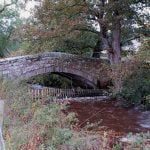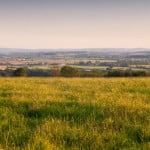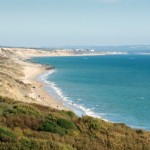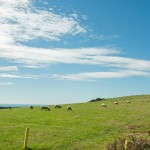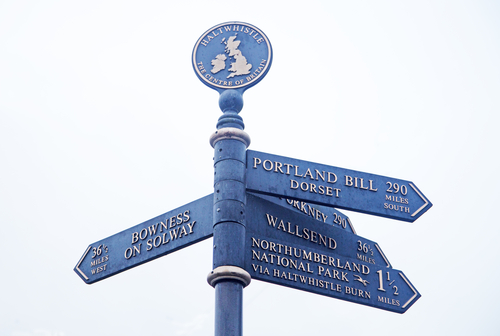
Bowness-On-Solway, Cumbria’s Little Gem
Bowness-On-Solway is a village and civil parish located on the Cumbrian coast in the extreme North West of England. The village lies some 14 miles northwest of Carlisle, situated on the Solway Firth estuary, from where Scotland is almost spitting distance. It consists of just several hundred people and the whole parish is made up of 3 other small villages and a few hamlets.
Bowness is undoubtedly best known for being at the western end of the famed Hadrian’s Wall, one of England’s top tourist destinations. The Wall itself in the area is no longer in evidence, at least above ground level. However, Bowness was once the site of the large Roman fort of Maia. Today, the village makes up part of the Solway Coast’s designated Area of Outstanding Natural Beauty (AONB).
Bowness-On-Solway A Fleeting History
It’s supposed that the Bowness-on-Solway area was first settled during the Neolithic Age, somewhere between 2500 BC and 4500 BC. Bronze Age, the Beakers, and Iron Age peoples are all thought to have followed those from the late Stone Age. However, it was largely the Romans who put Bowness-on-Solway on the map. They arrived in the area around 71 AD, though they did not begin construction of the 73-mile long Hadrian’s Wall until around 122 AD.
In 128 AD, they also began the construction of Fort ‘Maia’ at Bowness, which became the most north-westerly outpost of their empire. It’s thought the military base at Bowness was continuously occupied for more than the next 250 years, eventually being abandoned somewhere around 383 AD. By 410 AD, the Romans had withdrawn from Britain altogether.
The Vikings Pay Bowness A Visit to Bowness-On-Solway
The Vikings first invaded England at the end of the 8th century. However, it’s thought they did not settle the Bowness area until around 900 AD. The ancient custom of ‘haaf net’ fishing is thought to be a practice passed on by the Norse settlers to the Solway area. Another legacy of local Viking settlement is the name of the village itself. The name ”Bowness” is thought to be derived from the Old Norse words of ‘bogi’ and ‘nes’, translating as rounded or bow-shaped headland.
Following the Norman invasion and the drafting of the Domesday Book in 1086, the parish of Bowness-on-Solway was formally drawn-up. In the 12th century, St Michael’s church was constructed, mostly from stone robbed from Hadrian’s Wall.
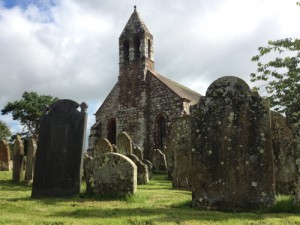
St Michael’s Church dates to the 12th century
Death of a King
It may be surprising to find that King Edward I, ‘The Hammer of the Scot’, died only a few miles from Bowness at the nearby village of Burgh-by-Sands. In early July 1307, Edward found himself in the Solway area, with his army, whilst in pursuit of the troublesome newly crowned King of Scotland, Robert the Bruce. However, on 7 July, the king died in the arms of his servants having succumbed to dysentery, bringing to an end his 35-year reign. Edward’s body was eventually taken south to lie in state at Waltham Abbey, before being buried in Westminster Abbey on 27 October.
Rise of the Border Reivers
Following the death of Edward I, the early 14th century saw the rise of the Border Reivers. The gang of marauders was based along the Anglo-Scottish border, many close to Longtown, only 25 miles away. Their ranks consisted of both Scots and English brigands who plundered the Borderland area without prejudice. As a result, many of the dwellings of any substance that were built along the Solway coast were heavily fortified. Even churches in the area were often built with pele towers.
It was from the early 16th century to the mid-17th century that the Border Reivers were particularly active in the Bowness area. In one attack in 1626, the raiders stole the bells from St. Michael’s church at Bowness. However, they were lost in the Solway in the attempt to take them back to the Reivers border enclave. Not to be outdone, the Bowness villagers reacted by raising a raiding party of their own. They proceeded to steal the church bells from the small Scottish border villages of Dornock and Middlebie. The bells have been retained by Bowness ever since (see below).
The Solway Viaduct
By the early 1860s, more than 100,000 tons of iron ore was being shipped annually from West Cumberland to Scotland. In 1869, a private railway line, the Solway Junction Railway, was opened between Bowness and the Scottish border town of Annan. It connected the Maryport and Carlisle railway to the Scots rail system, avoiding the need to pass through Carlisle. The construction of the 1 mile 176 yards (1.75 km) long iron girder viaduct across the Solway estuary meant that nearby Port Carlisle could no longer receive shipping. Though, construction of a larger and deeper dock at nearby Silloth had already initiated the once busy Port Carlisle’s demise.
The viaduct underwent costly repairs in 1875, and again in 1881, due to extensive frost damage. General high maintenance costs meant the line was never to realise its investors’ expectations. It withdrew its passenger operation in 1914, and that for freight in 1921. The structure was totally demolished in 1934, though some evidence of the viaduct’s abutment construction still remains in place today.
Today’s Bowness-On-Solway
Bowness is in a relatively remote rural location and consists of less than 100 houses. At the 2011 national census, the whole of the 12 sq. mile parish was found to have a population of just 1,126. Even today, the village and wider parish has very much managed to retain it’s agricultural heritage and identity.
There are 36 listed buildings throughout the parish. Only one is Grade I listed, which is Drumburgh Castle, a privately owned fortified house that dates back to the 13th century. Though, it’s obviously been altered and rebuilt several times through the centuries. St Michael’s Church and Fingland Farmhouse are Grade II* listed, while the remainder are all at Grade II listing.
Bowness-On-Solway – Did you know?
- Every new vicar who is appointed to the church over the border at Annan is obliged to request the return of the Dornock and Middlebie church bells. However, the request is always very politely refused.
- The Solway Viaduct was sometimes used as a pedestrian crossing of the Solway. This was particularly true on Sundays, when Scots would sometimes stroll across to England. This was mainly to indulge in a drink or two, as it was prohibited in Scotland on Sundays at the time. On the return journey, presumably when revellers were in less than sober state, it was not unknown for the odd one to disappear without trace.
Getting To Bowness-On-Solway
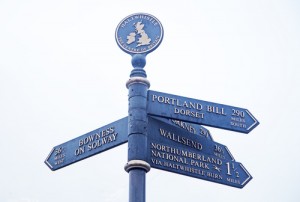
Image: AC Rider/Shutterstock.com
By far the easiest way to get to the relatively remote Bowness-on-Solway is by private car. Unless you’re travelling from West Cumbria, it’s probably best to take the M6 to Junction 44, then turn off onto the A689 and head for Workington. Turn off at the Burgh Road roundabout and follow the road for around 10 miles all the way to Bowness.
The alternative way to get to Bowness-on-Solway is to take the train to Carlisle. However, you will then need to make the remaining 15 miles part of the journey by either bus or taxi. A direct bus to Bowness departs from Carlisle’s Market Hall, three times a day, Mondays to Saturdays. The journey takes approximately 40 minutes. A taxi will obviously be much faster but expect to pay around £40.
Things to see and do around Bowness-On-Solway
Hadrian’s Wall
- Hadrian’s Wall Path is 84 miles (135 km) long National Trail that opened in 2003. It runs from Bowness-on-Solway on the west coast to Wallsend on the east coast of England. It generally follows the route of Hadrian’s Wall over the majority of its length.
St Michael’s Church
- The 12th century St Michael’s Church was largely restored in 1891. It’s situated on what is thought to be the site of one of the buildings of the old Roman fort. The church, like many of the area’s ancient buildings, is partly constructed from stone taken from Hadrian’s wall.
- Situated within Solway Coast AONB, Campfield Marsh RSPB Reserve and the Solway Wetlands Centre is just a short walk from the village. The local sand dunes, salt marsh, shingle beds, and peat mosses make the area a haven for a variety of fauna, including adders. Oystercatchers, curlew, plover, lapwing, knot, dunlin, godwit and redshank, are just some of the wild birds that can be observed.
Visit Carlisle
- Bowness is an ideal location from which to explore the local area. The historic county town of Carlisle, just 15 miles away, is well worth a visit. However, both the Scottish Borders and the North Lakes, are also just a short drive away.
- About 7 miles from Bowness-On-Solway, close to the mouth of the River Eden at Burgh-by-Sands, there’s a monument that marks the exact spot where King Edward I died. The red sandstone memorial, originally erected in 1685, is now a Grade II listed structure.
Accommodation and Bed & Breakfast in Bowness-On-Solway
The main type of accommodation in and around Bowness are holiday cottages and apartments. Typically, expect to pay £70 – £120 per night for 2 adults sharing. You can expect reductions where there are more people sharing or for longer stays.
Ad
Hunter Leisure Group Limited – Bowness-On-Solway
Hunter Leisure Group Provides a superb Holiday Home Complex right in the heart of Bowness-on-Solway.
Facilities available are;
- Bed & Breakfast
- Apartments
- Shepherd Huts
- Free Gym to Guests
- Motorhome Hire
- Restaurant and Bar
- Click for more information
Ad
Thinking of moving to Bowness-On-Solway?
Looking for the quiet life, then why not Bowness? With such a small housing stock, average prices can obviously be easily skewed. However, the best estimate of an average price for property in Bowness-on-Solway in the year ending April 2021 is around £295,000. Flats sold for an average of £112,000 and terraced houses for £176,000. Average prices were up around 12% on the previous year.
Five Minutes More?
Thanks for reading our Five Minute overview of Bowness on Solway. Before you go why not have a look at some of our other location guides. Better still if you are heading for Cumbria download our Your Cumbria App and have loads of information right at your fingertips. Or, if you’re a big fan of Cumbria, why not give the Big Fat Cumbria Quiz a go?
FAQs about Bowness-On-Solway
Where is Bowness on Solway?
Bowness on Solway is a village and civil parish located on the Cumbrian coast in the extreme North West of England. The village lies some 14 miles northwest of Carlisle.
What is Bowness on Solway best known for?
Bowness is undoubtedly best known for being at the western end of the famed Hadrian’s Wall, one of England’s top tourist destinations. The Wall itself in the area is no longer in evidence, at least above ground level. However, Bowness was once the site of the large Roman fort of Maia. Today, the village makes up part of the Solway Coast’s designated Area of Outstanding Natural Beauty (AONB).
What is the Population of Bowness-on-Solway?
At the 2011 national census, the whole of the 12 sq. mile parish was found to have a population of just 1,126.
When was the Solway Viaduct Built?
1869, a private railway line, the Solway Junction Railway, was opened between Bowness and the Scottish border town of Annan. It connected the Maryport and Carlisle railway to the Scots rail system, avoiding the need to pass through Carlisle. The construction of the 1 mile 176 yards (1.75 km) long iron girder viaduct across the Solway estuary meant that nearby Port Carlisle could no longer receive shipping. Though, construction of a larger and deeper dock at nearby Silloth had already initiated the once busy Port Carlisle’s demise.
When was the Solway Viaduct taken down?
The viaduct underwent costly repairs in 1875, and again in 1881, due to extensive frost damage. General high maintenance costs meant the line was never to realise its investors’ expectations. It withdrew its passenger operation in 1914, and that for freight in 1921. The structure was totally demolished in 1934, though some evidence of the viaduct’s abutment construction still remains in place today.
What is the average house price in Bowness-on-solway?
With such a small housing stock, average prices can obviously be easily skewed. However, the best estimate of an average price for property in Bowness-on-Solway in the year ending April 2021 is around £295,000. Flats sold for an average of £112,000 and terraced houses for £176,000. Average prices were up around 12% on the previous year.


